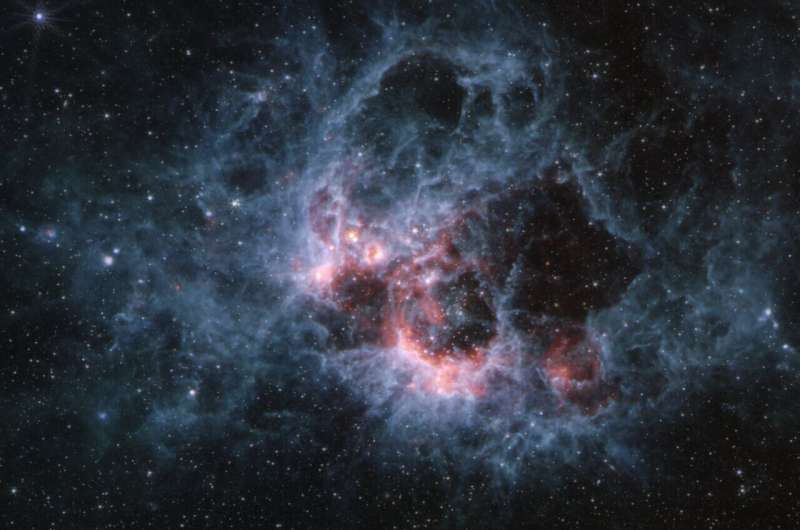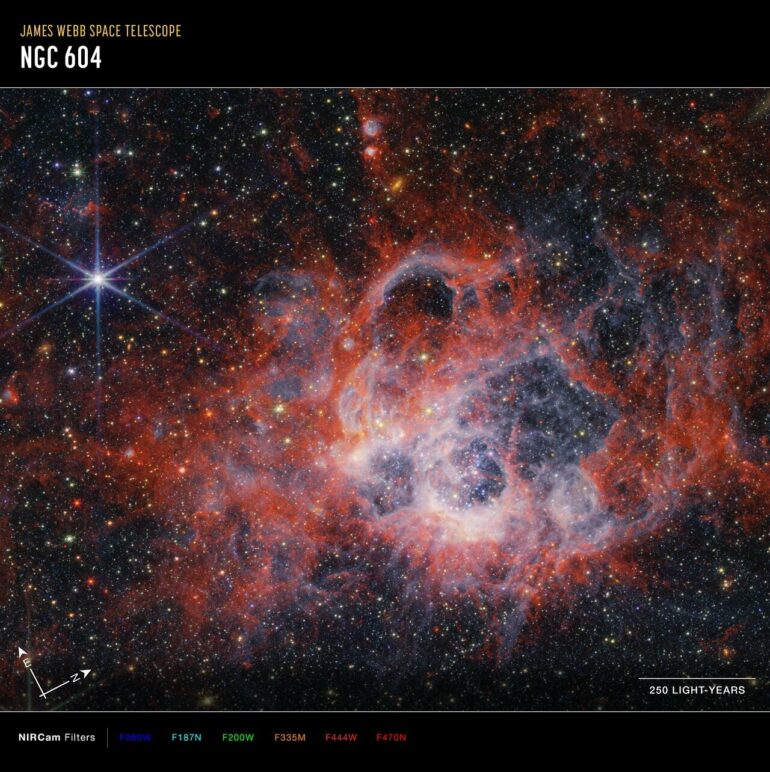Two new images from the NASA/ESA/CSA James Webb Space Telescope’s NIRCam (Near-Infrared Camera) and MIRI (Mid-Infrared Instrument) showcase the star-forming region NGC 604, located in the Triangulum galaxy (M33), 2.73 million light-years away from Earth. In these images, cavernous bubbles and stretched-out filaments of gas etch a more detailed and complete tapestry of star birth than seen in the past.
Sheltered among NGC 604’s dusty envelopes of gas are more than 200 of the hottest, most massive kinds of stars, all in the early stages of their lives. These types of stars are known as B-types and O-types, the latter of which can be more than 100 times the mass of our own sun. It’s quite rare to find this concentration of them in the nearby universe. In fact, there’s no similar region within our own Milky Way galaxy.
This concentration of massive stars, combined with its relatively close distance, means NGC 604 gives astronomers an opportunity to study these objects at a fascinating time early in their life.
In Webb’s near-infrared NIRCam image, the most noticeable features are tendrils and clumps of emission that appear bright red, extending out from areas that look like clearings, or large bubbles in the nebula. Stellar winds from the brightest and hottest young stars have carved out these cavities, while ultraviolet radiation ionizes the surrounding gas. This ionized hydrogen appears as a white and blue ghostly glow.
The bright orange streaks in the Webb near-infrared image signify the presence of carbon-based molecules known as polycyclic aromatic hydrocarbons, or PAHs. This material plays an important role in the interstellar medium and the formation of stars and planets, but its origin is a mystery. As you travel further from the immediate clearings of dust, the deeper red signifies molecular hydrogen. This cooler gas is a prime environment for star formation.
Webb’s exquisite resolution also provides insights into features that previously appeared unrelated to the main cloud. For example, in Webb’s image, there are two bright, young stars carving out holes in dust above the central nebula, connected through diffuse red gas. In visible-light imaging from the NASA/ESA Hubble Space Telescope, these appeared as separate splotches.

This image from the NASA/ESA/CSA James Webb Space Telescope’s MIRI (Mid-Infrared Instrument) of star-forming region NGC 604 shows how large clouds of cooler gas and dust glow at mid-infrared wavelengths. At the center of the image is a nebula on the black background of space. The nebula is composed of wispy filaments of light blue clouds. At the center-right of the blue clouds is a large cavernous bubble. The bottom left edge of this cavernous bubble is filled with hues of pink and white gas. Hundreds of dim stars fill the area surrounding the nebula. © NASA, ESA, CSA, STScI
Webb’s view in mid-infrared wavelengths also illustrates a new perspective on the diverse and dynamic activity of this region. In the MIRI view of NGC 604, there are noticeably fewer stars. This is because hot stars emit much less light at these wavelengths, while the larger clouds of cooler gas and dust glow.
Some of the stars seen in this image from the surrounding galaxy are red supergiantsâstars that are cool but very large, hundreds of times the diameter of our sun. Additionally, some of the background galaxies that appeared in the NIRCam image also fade. In the MIRI image, the blue tendrils of material signify the presence of PAHs.
NGC 604 is estimated to be around 3.5 million years old. The cloud of glowing gases extends to some 1,300 light-years across.
Provided by
European Space Agency
Citation:
Webb peers into the tendrils of NGC 604 (2024, March 11)



